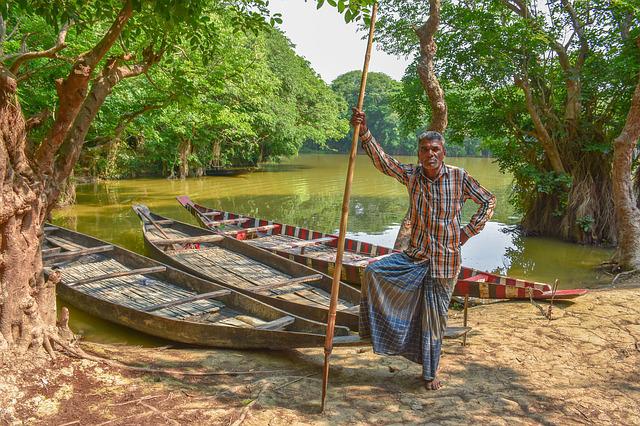Sundarban mangrove forest is one of the most beautiful forests yet full of mysteries and dangers. People of Calcutta always get excited while fantasizing about the beauty of Sundarban. The Sundarban is rich in mangrove trees while surrounded by a mysterious aura of something that locals believe to be the God or Goddess of the forest.
In 1987, the Sunderbans was designated as a Cultural UNESCO World Heritage Site. The Royal Bengal Tiger, India’s national animal, lives in the Sundarbans. Despite the danger, tourists are attracted to see the Royal Bengal Tiger.
Where is Sundarban Mangrove Forest?

Sundarban mangrove forest is located on the Bay of Bengal’s Ganga, Brahmaputra, and Meghna deltas. It stretches from the Baleswar River in Bangladesh’s Khulna division to the Hooghly River in India’s West Bengal state.
Sundarbans is known as the world’s largest mangrove forest. It covers about 10,000 square kilometers in the eastern Indian state of West Bengal and the western Khulna Division of Bangladesh. If you’re wondering whether Sundarban is located in India or Bangladesh, then it’s pretty confusing for most people.
Sunderban is in the Indian state of West Bengal, in the districts of North and South 24 Pargana. Sundarban National Park, tiger reserve, and biosphere reserve are located in West Bengal, India. However, it is part of the Sundarbans on the Ganges Delta and adjacent to the Sundarban Reserve Forest in Bangladesh.
History of Sundarban Mangrove Forest
The Sundarbans region has a long history of human habitation dating back to the Mauryan era (4th-2nd century BCE).
During the Mughal period, local rulers leased out forest tracts to establish settlements. The British East India Company obtained exclusive rights to the Sundarbans from Mughal Emperor Alamgir II in 1757 and completed mapping the area in 1764.
However, In 1869, the first Forest Management Division with jurisdiction over the Sundarbans was established. Under the Indian Forest Act of 1865, a large portion of the mangrove forests were designated as reserved forests in 1875.
The Sundarban was named after the word “Sundari” (mangrove). “Sundar” also means “beautiful,” and the forest is full of enchantment and natural beauty. And the word “ban” means “forest.” So, in essence, we call it Sundarban. The area is intersected by small rivers, streams, and waterways.
Trees of Sundarban Mangrove Forest
A tree with roots above the earth’s surface is known as a mangrove, and the Sundarban is abundant in these trees. We can see why Sundarban is known as the world’s largest mangrove forest.
The storyline does not end here. In addition to the sundari, other tree species in the forest include Avicennia, Xylocarpus mekongensis, Xylocarpus granatum, Sonneratia apetala, Bruguiera gymnorhiza, Ceriops decandra, Aegiceras corniculatum, Rhizophora mucronata, and Nypa fruticans palms (mangrove).
In the Sundarbans, 26 of the 50 broad mangrove species that can be found worldwide thrive.
Several studies have found a unique interaction between endophytes and mangrove host plants (Castro et al., 2014). Mangrove tree species have a greater influence on the distribution of the associated bacterial community than sampling depths.
However, based on recent research, we can assume that this observation also applies to the Sundarbans mangroves. Extensive metagenomics research is needed to fully understand the functioning and resilience of mangroves in the Sundarbans.
Animals of Sundarban Mangrove Forest

The Sundarban mangrove forest is the Royal Bengal Tiger’s single largest habitat ( Panthera tigris ).
Sundarban is also the only mangrove forest in the world with an indigenous population of tigers. According to the 2004 census, there are approximately 58 species of mammals, 55 species of reptiles, and approximately 248 bird species in Indian Sundarban.
Sundarban has 693 species of wildlife, including 49 mammal species, 59 reptile species, 8 amphibian species, 210 white fish species, 24 shrimp species, 14 crab species, and 43 mollusk species. One of the property’s most appealing features is the 315 species of waterfowl, raptors, and forest birds that can be found there, including nine species of kingfishers and the marvelous white-bellied sea eagle.
Moreover, other animals include boars, spotted deer, raccoons, and Rhesus squirrel monkeys. The King cobra, popular cobra, Banded krait, and Russell’s viper are among the venomous reptiles found in the Sundarban, while the Python, Chequered Kil-Back, Dhaman, Green Whip Snake, and several other species are non-venomous snakes.
Royal Bengal Tiger – the main attraction of Sundarban Mangrove Forest

Sundarban is the only mangrove forest in the world with tigers, and not just any tigers, but the legendary Royal Bengal Tiger.
Nowadays, people visit Sundarban to see the Royal Bengal Tiger. Bengal Tiger is one of the most rare yet dangerous tiger species in the world.
The majority of Asia’s remaining tigers are now protected in Sundarbans. The word “Sundarban” means “beautiful forest” and evokes superlatives such as massive size, incredible biodiversity, and violent storms.
Bengal tigers make up about half of the world’s wild tiger population, making them the most numerous of the six tiger subspecies. Bengal tigers are an endangered species, despite being a symbol of Bangladesh and India. The Sundarbans National Park in West Bengal, India, is home to the majority of the world’s Bengal tigers.
A term referring to the survival of the Sundarban forest, the tiger revival of the Sundarbans expresses the cultural importance of tigers.
Also Read, How Royal Bengal Tiger Is Important For Sundarbans Mangrove Forest [2023]
The Importance of Sundarban Mangrove Forest

Sundarban mangrove forest is not only a natural wonder but also vital to our environment and the animals that live there.
The Sundarbans is vital for globally vulnerable species such as the Royal Bengal Tiger, Ganges and Irawadi dolphins, estuarine crocodiles, and the nearly extinct endemic river terrapin (Batagur baska). Panthera tigris has no other mangrove habitat in the world.
The Sundarbans are an important example of ongoing ecological processes because they represent delta forming and the subsequent establishment of newly formed deltaic island chains and associated mangrove populations. This process promotes our atmosphere by causing monsoon rains, flooding, delta formation, tidal influence, and plant colonization.
Places To Visit in Sundarbans
Sundarban is one of India’s most beautiful tourist destinations. If you want to witness the beauty of greenery, forest, wildlife animals, and ambiance of true nature, Sundarban is your destination to visit for.
However, Sundarban National Park is full of the Sundarbans’ history, wildlife, and culture. If you like to experience new places, Sundarban of India should be on your bucket list.
There is no denying the mystic beauty of this location, but it is not recommended to visit the mangroves at the height of the summer. And November to February is the best time to visit the Sundarban Mangrove forest.
Here are some recommendations in Sundarban National Park that you should consider visiting if you plan to go there.
Sajnekhali Bird Sanctuary: Many kingfishers, mongooses, wild boars, and parrots can be seen in this area. The forest is stunning. Beautiful sunsets and river waters are both present.
Sudhanyakhali Watch Tower: The Sundarban Jungles can be seen from this watch tower. It’s a great place to walk around on land after a few hours on the beat looking for wildlife. There will be many deer, crabs, birds, and ducks to see.
Sunderbans National Park: Sundarban National park is a great tourist attraction in Calcutta, India. People love to visit there to witness the beauty of mangroves, wildlife rare animals, and the legend Royal Bengal Tiger.
Sundarban Wild Safari: This place is fantastic because of the rivers, the canals, the mangrove forest, the tigers, the birds, and the canoes. Although the accommodations are typically modest. But a visit here is worthwhile just for the sights, sounds, and smells.
Mangrove Eco Garden: The Calcutta Wildlife Society, an NGO, founded the garden in 1995. In this garden, an NGO protects 55 endangered mangrove species. For the location, it is the ideal setting for researchers, students, and tourists.
Tin Kona Island: There are crocodiles, some of which can grow to be enormous, water monitor lizards, various birds, deer, crabs, and wild boars, but sadly no tigers. Your trip will be incredible, thanks to all of these things. However, there is no electricity or running water in the isolated area. Everything must travel by boat to these islands and villages.
How To Visit Sundarban mangrove forest In India

If you are an Indian, you can easily visit there. Simply take a train from Canning, which is approximately 48 kilometers from Sunderban National Park.
If you want to fly there, the nearest airport to the Sunderban National Park is Netaji Subhash International Airport in Dumdum, Kolkata, which is roughly 112 kilometers away.
On the other hand, foreigners require a permit and a current passport for entry into Sundarbans National Park. The West Bengal Tourism Office in Kolkata and the forest department in Sajnekhali both issue permits. A tour operator will handle making these arrangements for you if you travel with them.
Frequently Asked Questions About Sundarban Mangrove Forest
Which is the world’s largest mangrove forest?
Sundarban mangrove forest is the world’s largest mangrove forest. It is rich in beauty, full of mysteries, wildlife and rivers, beaches, and Islands.
How are Sundarbans formed?
Sundarbans is a mangrove region in the Bay of Bengal delta formed by the convergence of the Padma, Brahmaputra, and Meghna rivers. It extends from the Baleswar River in Bangladesh’s Khulna division to the Hooghly River in India’s West Bengal state.
Which is the main trees of Sundarbans?
Sundari (mangrove) is the main attraction tree of Sundarbans. However, Avicennia, Xylocarpus mekongensis, Xylocarpus granatum, Sonneratia apetala, Bruguiera gymnorhiza, Ceriops decandra, Aegiceras corniculatum, Rhizophora mucronata, and Nypa fruticans palms are among the other tree species in the forest in addition to the mangrove trees.
What will happen if we lose Sundarbans?
Sundarban play a very important role in protecting our atmosphere. The loss of the mangrove forest means the loss of the biological shield that protects against cyclones and tsunamis.
Why is Sundarban shrinking?
Since 1991, the forest has lost nearly 16 square kilometers of vegetation per year due to human encroachment and climate change. The Sundarbans, the world’s largest continuous mangrove forest, spanning more than 10,000 square kilometers along the Bay of Bengal, is shrinking.
How many Islands are there in Sundarban?
There are 102 Islands in Sundarban. Of the 102 islands, 54 are inhabited, with the remainder covered by forests. Furthermore, while India owns 40% of the total area of the Sundarbans, Bangladesh owns the remaining amount.
In which state Sundarban National Park is located?
Sundarbans National Park is located in southeastern West Bengal state, northeastern India.
Can I see Tiger in Sundarbans?
Yes, Of course! You can see the Royal Bengal Tiger in Sundarbans national park. Just visit the Sundarban wild safari in Sundarban national park; you will see many more wildlife animals than just a tiger.
References: 1. Wikipedia. 2. Sciencedirect. 3. Sundarban National Park. 4. UNESCO. 5. GrabOn.







